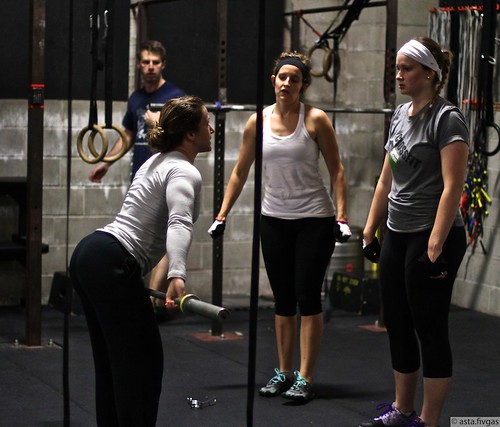
Seven-plus years in and I still see CFSBK as a continuous work-in-progress. Reflecting back on our earlier years, I wince a little at the way we could have been doing things better, given the 20/20 vision that comes with learning from experience. That's not to say we haven’t always attempted to deliver an excellent service, cared about our members, and poured passion and love into all our classes; but it does mean that we're constantly tweaking our program and experimenting with how we can evolve the gym. Starting a business from scratch involves a lot of learning by trial-and-error. In the broader world of fitness, it wasn’t so long ago that CrossFit was the new kid on the block, and we’ve all had to figure many things out as we’ve gone along. This process of learning and sharing is largely why I started ITA in the first place; if you can benefit from the solutions CFSBK has discovered, all the better.
But part of growing a successful business involves embracing the actual process of growth, and constantly learning to serve your community and population better than any one else can. One of the most effective ways we’ve learned to learn involves soliciting direct feedback from our members. We’ve done this in two main ways: first, by using various feedback forms, and second, by maintaining an open dialogue on our blog.
 General Feedback Form
General Feedback Form
CFSBK recently used this form to gather community-wide feedback from our members about how they experience our group classes and program in general. The form covers basic demographics such as how long people have been members and how they get to the gym (driving, biking, walking, etc.) as well as more open-ended questions regarding staff, atmosphere, and any general ways we could improve. We left identification optional, meaning people could choose whether to provide their name. About half of the responses were attached to a name and half were anonymous. Allowing responses to be anonymous opened the door to more critical feedback, since people felt safe to share without fear of offending someone in particular—though I was pleased that so many members of our community felt safe offering honest thoughts with their names attached, too.
We ended up with about 120 responses, which divided fairly naturally into three categories: program requests, good ideas, and any reoccurring negative feedback. All of our coaches on staff read each response and we have been discussing them in our weekly meetings. Some changes we wanted to make were easy to implement while others will take a little more work. Other changes we’d like to make but we can’t yet, since we’re limited by our available resources (primarily space).
While it can be difficult to hear criticism about the thing you've been pouring your heart into for several years, it's extremely important to assess these concerns rationally and not allow an emotional reaction to steer your perspective on the feedback. Listen to your members, assess the feedback objectively, and improve in the ways that align with your vision and intuition.
 Program Specific Feedback Form
Program Specific Feedback Form
CFSBK also uses smaller-scale feedback forms to assess particular programs beyond group classes and the general community. For example, this form is sent out to people after they graduate our Foundations program. We think it's especially important to hear from new members since first impressions are so important and little things could lead to such significant consequences later on; for example, someone who could have been a long-term, influential member of your community might have a mediocre experience for a few fixable reasons and decides not to start CrossFit. If you can figure out how to avoid this and improve, all the better. Additionally, sending out the form at all demonstrates to new members that their opinions are important at CFSBK, and it further opens the dialogue between our staff and members. It's also just nice to follow-up and see what peoples’ post-Foundations plans entail.
As I mentioned, we’ll also employ similar feedback forms for programs such as our new Endurance Program or our Strength Cycle.
There is no shortage of excellent services you can employ to generate surveys, but I’d love to give a shout-out to wufoo.com, which we use for all of these forms. We use it because it is really easy to set up and the interface is very straightforward.
 Using Your Blog to Gather Feedback
Using Your Blog to Gather Feedback
In “Building Community Through Your Blog,” I wrote about how much of an opportunity you have on your blog to communicate with your members. All CrossFit affiliates are required to have and maintain a blog, but many affiliates prioritize other forms of social media, such as Facebook. CFSBK has found a blog to be the best way to maintain an open, constructive dialogue, since we get to establish the norms for what’s appropriate (think YouTube comments to put that into perspective). Obviously not everyone posts, but the people who do give our coaches an opportunity to get a daily sense of how things are going.
A long time ago, the tone of our blog was set such that people expound beyond simply their numbers and share their experience of the programming that day. For example, someone might post their squat numbers but also add a couple sentences about how frustrated they’ve been recently with squatting for x and y reasons. Then, whatever a coach next has them in class, they can hone in on that person’s concerns more acutely. If this sounds interesting to you, start by posting your own training numbers and experience, and invite other coaches and members to join you in sharing their written thoughts.
Concluding Thoughts
I'll leave you with a short video by NPR personality Ira Glass about good taste and developing your craft. His theme of putting in the time, developing slowly, and continuously improving are as applicable to radio broadcasting as they are to running an affiliate. Let your vision and taste guide your decisions, but don't be afraid to open yourself up to feedback from the people who are most important to the success of your affiliate.